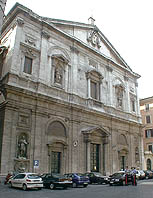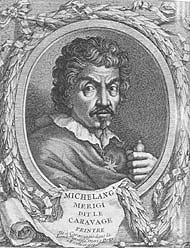St. Luigi dei Francesi
The French Church (1589, Fontana), the Caravaggio Church. The facade is almost too clean for Rome, and the whole atmosphere is pompous, a very un-Italian quality.
But follow the crowds to the fifth chapel on the left, just before the altar, and you will be entranced with three paintings by Michelangelo Merisi (1571-1610), from the North Italian town of Caravaggio, from which he took his "nom de peintre", Caravaggio!
The facade is usually attributed to Giacomo della Porta, but the ensemble is probably the work of Domenico Fontana.
Caravaggio's three masterpieces in the Contarelli Chapel represent "St. Matthew and the Angel" (over the altar), the Calling (on the left) and the "Martyrdom of St. Matthew" (on the right).
Notice the exaggerated but lifelike positions of the figures, and the drama built up by the illumination coming from a single source, like a theatrical spotlight. Caravaggio started the Neopolitan school of painting where the poor and the sick were subjects. He invented "reality" (see the dirty soles of the feet).
Notice how far painting had come since the more classic works of Michelangelo and Raphael, created within one hundred years.
Caravaggio was banished to Naples because he had killed a man in a knife fight. He died on the beach walking back to Rome as a penance before he knew the Pope had pardoned him.
 St. Luigi dei Francesi 1478. Rome's French colony acquired a small church in this quarter of Rome, which is still identified with Gallic culture. 1518. Cardinal Giulio de Medici, future Pope Clement VII, laid the cornerstone. 1589. San Luigi was consecrated as the official church in Rome for the French, dedicated to their King Louis IX who led two Crusades and was made a saint. 1597. Caravaggio started his five year cycle of paintings. |
Via Santa Giovanna d'Arco. Tel. 06 688271. (Map G 5)
Open daily 8 am to 12:30 pm and 3:30 to 7 pm. Closed Thursday pm